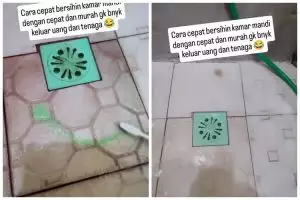Brilio.net - Scale stains are a common problem that often occurs in bathrooms. Water deposits containing minerals such as lime and calcium are often the main cause of limescale in the bathroom , especially on the floor. Apart from water deposits, crust can also come from soap residue or dirt carried when bathing.
Scale prevention is an important key to keeping your bathroom clean and free of unwanted mineral deposits. One of the most effective ways to prevent limescale is to dry bathroom surfaces after use. You can use an exhaust fan or air suction device to keep the bathroom dry after use.
However, if the bathroom floor is already crusty, you also have to remove the crust. Usually a number of people will use a special mixture of ingredients to eradicate limescale on the bathroom floor. This special ingredient mixture can come from a mixture of porcelain cleaning fluid and bleach.
But instead of making a special mixture of ingredients, you can use other, more practical ingredients like those used by Instagram user @izarazim. Through one of the uploaded videos, he admitted that he used two simple ingredients to eradicate limescale on the bathroom floor. Well, one of the ingredients comes from the kitchen, you know.
"This way to clean the bathroom quickly and cheaply without spending a lot of money and energy," said Instagram @izarazim.
How to clean limescale on the bathroom floor.
Reported by BrilioFood on Wednesday (22/5), the kitchen ingredient in question is dishwashing soap. Then another ingredient used is citrus. So these two materials will later be applied directly to the bathroom floor.

photo: Instagram/@izarazim
How to use it: pour dish soap directly onto the crusty floor area. Then sprinkle enough citrus on that part. If so, scrub using a brush evenly until the crust is completely gone.

photo: Instagram/@izarazim
If it has been brushed evenly, then rinse the bathroom floor with running water. Shortly after rinsing, the bathroom floor, which was originally crusty black, looked shinier. However, if there are still crusty stains attached, you can repeat the process. Then let it sit for a few minutes before brushing.

photo: Instagram/@izarazim
Well, the bathroom floor that has been cleaned will look shinier. This condition will certainly make the bathroom shine as a whole. That way, the bathroom tends to be hygienic and comfortable to use.
How? Easy enough, right? You can copy this trick to clean limescale on the bathroom floor easily. The materials and tools required are very simple. Guaranteed to be effective and effective.
View this post on Instagram
Tricks to get rid of worms on bathroom ceramic floors.
Dealing with worms on your bathroom tile floor can be an annoying problem. Here are nine tricks to help solve this problem:
1. Cleaning with cleaning solution.
Use a strong cleaning solution to thoroughly clean the tile floor. Make sure to focus on areas where worms occur frequently.
2. Use hot water.
Pour hot water over the area affected by the worms. Hot water can help kill the worms and also clean the area.
3. Baking soda.
Sprinkle baking soda on the area affected by the worms. Leave it for a few hours or overnight before cleaning it with a soft brush or cloth.
4. White vinegar.
Mix white vinegar with water and spray it on the area affected by the worms. White vinegar can kill worms and also help remove unpleasant odors.
5. Eucalyptus oil.
Mix eucalyptus oil with water and spray it on the area affected by the worms. Eucalyptus oil has antiseptic properties and can help repel worms.
6. Mint leaves.
Place dry mint leaves on the area affected by the worms. Mint leaves have a strong aroma that repels worms.
7. Coffee grounds.
Sprinkle coffee grounds on the area affected by the worms. Coffee has acidic properties that can kill worms and also provide a refreshing aroma.
8. Clean regularly.
Cleaning the bathroom regularly can help prevent the appearance of worms. Make sure to clean all areas, including crevices and corners that are often overlooked.
9. Check the drain.
Check the bathroom drain to make sure there are no problems such as seepage or excess moisture that could attract worms.
